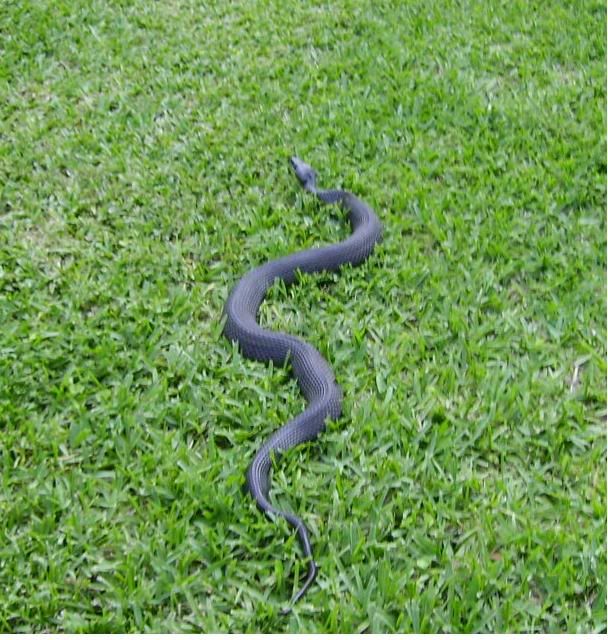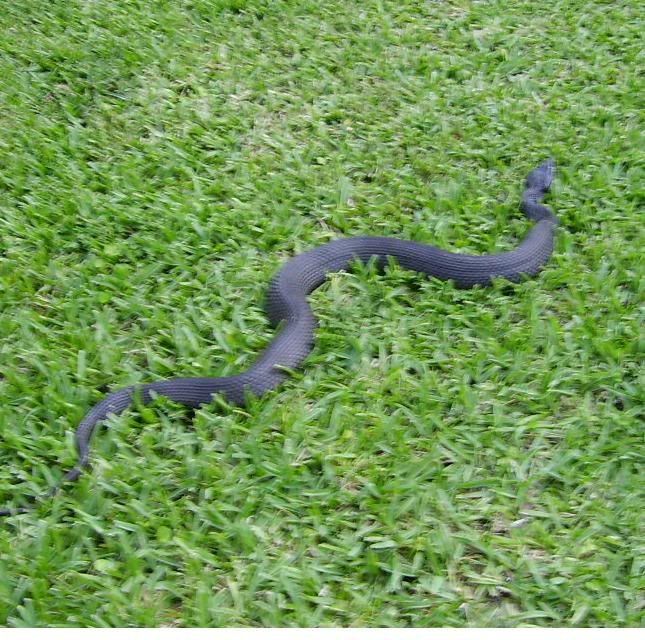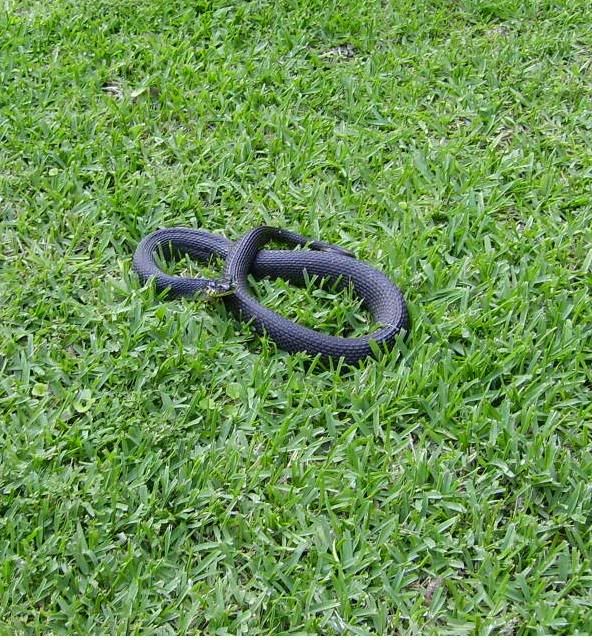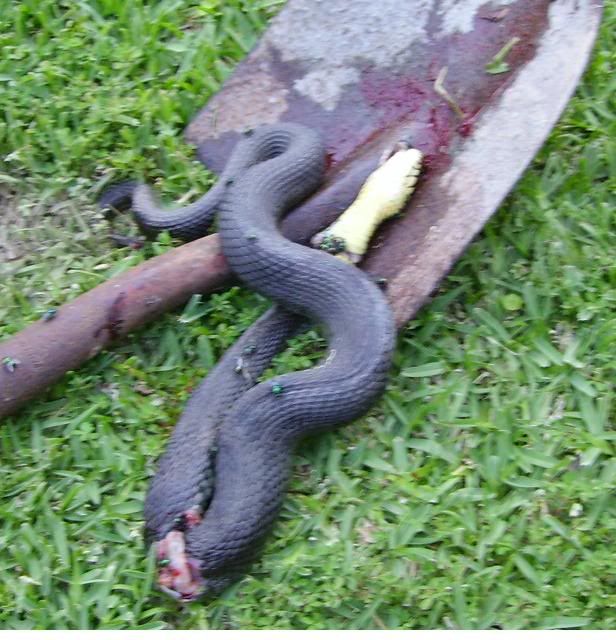
Posted on 05/09/2009 5:27:52 PM PDT by humblegunner
This afternoon I happened to look out the back and saw something
black and long in the middle of the yard. I just mowed yesterday
so I knew the yard was free of sticks and such.
Turns out it was a big black snake!
He isn't a rattler, does not look loke a water moccasin or a black snake.
What the heck kind of snake is he? He has the triangular head which
means he is a bad one, but I can't place his breed.
Anyway, photography being as dangerous as it is, he got wrecked up some
which is just as well. He might have bitten one of the animals.





So who knows any herpetology?
“I hope you got some really nice stuff for Mom today - she’s earned the best.”
Unfortunately, I lost my mom 5 years ago at age 83. She had a wonderful life and a merciful death and we know where she is now! She was quite the character though — a real tough cookie!
After further review that appears to not be a snake at all but a really long frog.
Well, you know how I feel about the French.

Your snake didn't look like this, though?
Well, first you are comparing someing walking up and kill a snake and then ask what kind is it to me wanting to see a vicious dog breed eliminated. Now, Pit Pulls come from lots and lots of breeding to make them vicious, that cannot be denied. I am not walking up to dogs and hitting them with shovels and then saying “Was this a pitbull” only to have some guy say, no, it was a poodle.
Finally, how many people die of snake bites in the US as compared to PitBulls yet folks walk around and kill snakes out of superstition, there is a difference, to those willing to think critically.
Every 40 seconds, someone in the United States seeks medical attention for a dog bite. There are approximately 800,000 bites per year in the United States that require medical treatment.
The snake in our logo is the speckled king snake, not the yellow-bellied water snake. I was talking about the snake in your first post, the snake you took a picture of IS a yellow bellied water snake. It is NOT a cottonmouth. I know for a fact 100%. My husband is a snake expert, has studied snakes for 40 years, and that snake was not a cottonmouth. I don’t know what makes you get off on killing snakes. Just leave em alone and they’ll leave you alone. They do a lot of good. Eating rodents, and even the venomous ones are used for medical research (venom helps with blood clots, cancer research etc).
HG has a point, it looked like a moccasin to him (and about 75% of thread respondents), and better safe than sorry or dead.
But the title of the thread is ‘What kind of Snake is This?’
and I’d like it cleared of being a viper if it’s not.
If this snake has migrated from Kentucky to ~Houston, we’ll see it soon enough here in centex.
If it’s not venomous, it’s a specimen to study and possibly encourage for pest control and not eradication.
What a Rorschach test this thread is. Freud would have a blast: snakes purportedly key to human unconscious sexuality.
Me, I just hike a lot and wind up bringing ‘em home for pets.
Looked like an earthworm to me.
My only point for the future is that many many times people are bitten by venomous snakes when attempting to kill them, so it’s better in the long run to just leave them alone - they don’t come up and attack you. They just want to be left alone as well. I was trying to answer the question of what kind of snake is this, which I did, and was rebuffed and told I was wrong and that it is a moccasin. I know that I am right and that it is not a moccasin. So I feel I have done my part in trying to be helpful.
PS “The triangular head means it’s venomous” is a myth - most nonvenomous snakes have triangular heads as well.
Yes, that is true. And in the state of Texas, only 1 or 2 people per year die of a snakebite, and those couple usually had pre-existing medical conditions.
Addictive snake game (found on FR from wakeupandvote)
http://www.onemotion.com/flash/snake-game/
from here
http://www.freerepublic.com/focus/chat/2164350/posts
You were blessed to have such a cool “mom”.
I HATE snakes!
Hey if I wasn't 100% sure I would have killed it also seeing as it was in the yard and then tried to make a better determination. I've killed several Copperheads in my life and make no apologies for doing so. ALL were near the house too close for safety.
Now I feel the same way about other animals as well like coons. I learned a lesson about them. I had a female raising about 5 close to my house. I watched them grow. I also noticed my neighbors were feeding them. The coons soon lost fear of humans and at that point became a danger. I tried to scare them off, baited them with food to an metal pan I had wired with an electric fence surger, and about everything possible. One morning they started growling at me and I said that's it they have to go. The next morning I emptied out the shotgun on them. Not something I enjoyed doing anymore than killing the Copperheads but safety of self and family comes first.
I can identify Copperheads in my region. The problem with Cottonmouths is like Copperheads. They vary in appearance region to region and at different stages of life. Looking at his pictures and not seeing a tail I would have killed it then and there. If I wasn't 100% sure I would have killed it for my families safety sake. I know enough about snakes to realize though that as least as far as Copperheads go a black snake will take one on and likely win.
I leave black snakes alone but in my area all black snakes are safe as we have no Cottonmouths but some swear we have Cottonmouths yet no offical confirmations by a wildlife biologist. I would feel far less remorse over killing a snake I later find out is harmless after more careful identification when it's dead than letting one go that was poisonous and still having it around my home and kids.
Humblegunner did the right thing. If it/was a Cottonmouth there's more near by just like Copperheads. Too if it is/was a Cottonmouth and considerable ways from water something is prompting them to go there like food sources or construction etc. If he were out and about somewhere in the wild or more remote location and saw the snake? Then I would say live and let live and leave it be.
“Geographic Range
Cottonmouths, Agkistrodon piscivorus , are found in the United States ranging from as far north as the James River in Virginia to the western edge of Missouri, and as far south as the Florida Keys and the western part of Texas. They are found in parts of North Carolina, South Carolina, Georgia, Kentucky, Illinois, Indiana, Tennessee and all of Louisiana, Alabama, Mississippi and Arkansas.”
~~~
Watch where ya’ step...;0)
Disclaimer: Opinions posted on Free Republic are those of the individual posters and do not necessarily represent the opinion of Free Republic or its management. All materials posted herein are protected by copyright law and the exemption for fair use of copyrighted works.